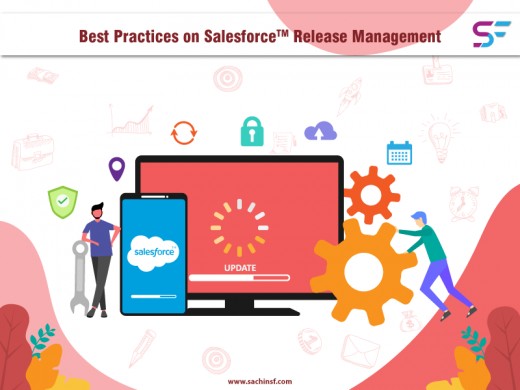Best Practices on Salesforce Release Management

Challenges for Salesforce Release Management
Here are some of the challenges faced by Salesforce org:
Complex Salesforce Orgs
The Salesforce environments are mostly complex and large and have large custom objects, profiles and permission sets. Any typical deployments consist of a few thousand members.
Multiple Release Environments
The code usually moves across multiple environments say SIT, UAT, stage etc. Finally, it is deployed in the production. The challenge lies in the maintenance of these various environments – with many pre and post-migration activities that are involved at each sandbox level.
Multiple Parallel Releases
The development and the release environments sync with each other and this constitutes a major challenge. The types of releases are : minor releases, major releases and hotfix releases. The minor releases are on configuration changes, the major releases are those released once in any quarter and the hotfix releases are those concerning of any business-critical issues occurring simultaneously.
Version Control
Changes occur to shared metadata members say custom objects and profiles. This results in overwriting of code. The challenge lies in maintaining the versions of changes, track them and roll them back in the Salesforce environment.
Challenges with Refresh
If the developer adopts refreshes frequently, then they are liable to lose their work-in-progress and this leads to a lot of manual steps for development teams. Quite often the developer sandboxes, release environments and production orgs go out of sync. All this is due to the fact that changes happen directly in Salesforce environment during releases and in some cases BRs are rejected in the UAT/Stage, not going live to production.
Now, it is time to come to best practices on Salesforce Release Management best practices.
Best Practices on Salesforce Release Management
Here are some of the best practices on Salesforce Release Management:
Designing the Right Sandbox Combinations for the Release
The right Sandbox composition is required for the release as per the various release phases. Salesforce has various sandboxes such as Developer, Developer Pro, Partial Copy and Full Copy sandboxes. These cater to various needs in organization – development, testing and training and more.
Continuous Integration for Automated Deployments
The teams need to collaborate, roll-back, perform change analysis and maintain isolation of code across multiple releases. Version control branches are used for version control setup for large enterprises. It is imperative to have a continuous integration settings, so that there is an early warning system, in case of integration issues as the developers need to integrate their code. This way the issues are fixed at the development stage itself.
Use Feature Branching and Pull Requests
It is normal for developers to use feature branching and pull requests for working with Git. But, we see the teams continue to use shared branches and cherry picked commit for production. You need to revisit the processes to continue to use the cherry picking commits along with hotfixes.
The individual developers/admins must work on personal sandboxes and then commit changes in the feature branch. The feature branch here represents a business change. The feature branch is pulled into integration branches, before deployed in the targeted production org.
Perform Code Review
For a successful source control and release management teams must adopt a code review culture. Code review incorporates the right tools and helps to improve quality and collaboration among the team members. This enables the team to stay in sync with the changes in the production environment.
Empower Users with Right Skill Sets for Release Management Process
Salesforce empowers the admins/business analysts. Support must be provided to these non-technical users in the forms of tools, with no need to learn XML, Git and Command lines, which enables them to take part in the Release Management process without any failure.
Modelling the Deployments
You must have a strategic deployment/Code Migration plan across the release environments. There must be a blueprint on Release Automation which tell about the flow of code from development to the production stage. These educates you on the extent of version control and streamlines the Release Management process.
Pre and Post Deployment Operations Checklist
There are many manual tasks to be done related to Metadata/Changeset constraints in Salesforce. One the best practices is to maintain a checklist on migration and refresh. This is only to inform the Release Management team to be notified on any issues.
Summary
Salesforce can be used by even the most non-technical users, with no need to understand code. The developers generally face lot of challenges on Release Management and one of these challenges is the maintenance of multiple release environments and the activities at the sandbox level. Yet another challenge can be that of syncing the development and release environments. There are various best practices that are used Salesforce Release Management. One of these best practices is about designing the right sandboxes, catering to various needs in organization in areas of development, training, and testing. In case of integration issues, there must be a continuous integration settings and a warning system. The non-technical users such as the business analysts must have the support of tools for taking part in the Release Management process, with no reason to fail.








